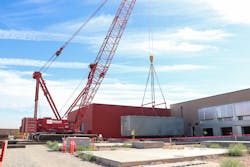How an Owner-Enabled Supply Chain Can Bring Transparency to Cloud Providers
Boots on the Ground Vantage Point
Over the last several years the data center construction market has been performing steadily and has started off very strong with a 29% increase from last year’s first quarter, shared during a Dodge Data & Analytics mid-year construction outlook. This strong start can be attributed to the high demand for data as companies continue the work from home trend brought on by the COVID lockdowns. Through our strategic partnership with ProLift Rigging, we have continued to serve stakeholders with boots on the ground support as they continue to navigate this construction demand with local warehousing, last mile hauling, and rigging support.
From our perspective and our partners boots on the ground vantage point in the construction process, the synchronization of the production and delivery of oversized and overweight critical products to construction sites has been a challenge for the upstream Cloud Provider. Well before COVID restrictions and the recent supply constraints, Cloud Providers experienced low visibility into reliable product ready, ship, and delivery dates due to high competition demand constraints.
Oftentimes, this leaves multiple layers of site contractors, such as ProLift Rigging, on standby and pushing construction end dates further right. A data center market conditions update report by Turton Bond stated that “delays are increasing pressure on schedules and driving construction costs higher. Datacenter operators with a primary focus on early procurement of key material and equipment (i.e. switchgear, UPS, chillers, generators, etc.) & building good relationships with vendors to guarantee delivery are finding success in a difficult market. Early procurements, off-site warehouse storage of key equipment & locking in prices before quarterly increases is the current recipe for successful procurement in a datacenter development.”
Back in 2019 ProLift shared this same sentiment in a DCF article, stating “your planned [data center construction] site is just a small piece to the booming data center construction market, and you run a high risk of becoming lost in the demand […] if proper buffering isn’t allocated to your schedule.” This is more relevant now than ever before. The impact of COVID restrictions and global material supply chain constraints have only elevated these issues, creating challenging dynamics for the Cloud Provider to meet their critical construction end dates.
Creating this dynamic of critical product demand planning, proactive procurement, vendor relationship management, logistics and transportation coordination, strategic warehouse locations, and site delivery and installation requires extreme ownership and visibility by all stakeholders involved. However, at the end of the day or construction project, the Cloud Provider is the one who takes the hit when extreme ownership and visibility between stakeholders is missing. Without transparency between all parties, the data center construction process is not functioning at max efficiency, leading to site construction delays, and missed opportunities for the Cloud Providers.
But who is responsible for advocating this transparency? We believe a strong construction supply chain management firm is the missing piece to the transparency that is desperately needed.
Building Owner Enabled Supply Chains
From years’ worth of conversations and experiences in the market, it is clear that many Cloud Providers are in a position to seize market opportunity and they need a partner to help combat the market constraints and accelerate the scaling of an elite supply chain team tailored to their size and operation. Cloud Providers need various levels of support depending on their growth plans and current operational constraints, such as immediate procurement and logistics team deployment and strategic sourcing of new vendor partners to deploy physical infrastructure faster.
From our experiences partnering with Cloud Providers, the most efficient and effective way to quickly deploy new data center sites is to build an unallocated inventory of OFCI products that can be predictably deployed to sites across the Cloud Provider’s strategic geography. In simple terms, decoupling the oversized and overweight critical cooling and power products from site level construction scope. To get there, legacy models of manufacturing, procurement, transportation and construction must be re-engineered so that ownership, incentives, metrics, and ultimately performance are aligned with the rapid innovation that impacts the Cloud Providers core markets.
What does this look like? Here are a few ways Cloud Providers can rethink their supply chain and construction process to help combat the current market constraints and ultimately build faster.
- Gain Visibility and Commitments from Tier 2, 3+ Suppliers: Tier 1 Suppliers are being impacted by lack of raw material, fabricated components, sub-assemblies, etc. We believe there are strategic opportunities to establish robust relationships with Tier 2 and 3 suppliers to ensure Tier 1 OEMs and Integrators are positioned to meet their commitments. This could mean taking control of critical tier 1 inputs. Finding a path to expand strategic sourcing services to help address this opportunity in both OFCI and CFCI procured products is critical, whether that’s self-developed or a strategic partner positioned to support this effort.
- VMI and Safety Stock/Buffered Inventory of OFCI Equipment: Dynamic demand to construct and deliver additional 40+ MW capacity within the “need by” constraints requires OFCI delays to be eliminated. With demand models that inform VMI and owned Inventory levels, owners need a solution to manage order execution and production, receipt and management of that inventory (chain of custody, quality, warranty, handling). Additionally, strategically located warehouse facilities are instrumental to the flexible deployment of equipment. Not only in the markets currently being targeted, but the ability to grow these capabilities quickly.
- Shift Transportation Scope Responsibility from Suppliers and Manufacturers to a Single Responsible Party: Manufacturers do not have a strategic focus on transportation. Their focus is on increasing production capability and capacity. Even if a manufacturer is skilled in procuring and coordinating transportation, Cloud Providers will experience fragmented transportation coordination because each of the various suppliers are responsible for the transportation of their product. This is a major cause of the lack of visibility to the entire supply chain inevitably leading to delays and inefficiencies.
- Shift Last Mile Delivery and Site Rigging from Suppliers and Site Subcontractors to a Single Responsible Specialty Contractor: The last mile delivery and site rigging is already being performed and executed at every project site, but with little control or visibility to the Cloud Provider. These rigging costs are already being incurred at the project level upstream to the Cloud Providers. By shifting the responsibility to a single provider, these costs will be shifted out of the Integrator, General Contractor, M&E Subcontractor, and local Crane and Rigging Subcontractor scopes. This move has the opportunity to save at least 20% or more on mark-up costs alone and allow for an owner-enabled supply chain. The key here is for the site to be completely ready for the Cloud Provider’s products prior to specialty contractors’ deployment to the field, eliminating standby time and rework. The perfect model is the “shell ahead” model where all civil, underground, foundations, and building shells are complete prior to the owner’s products being set, allowing for quicker installation, faster hookup, and lower overall heavy rigging costs.
Robert Moffit is the Executive Vice President of BluePrint Supply Chain. BluePrint Supply Chain accelerates the leaders of the industrial future, by strengthening, scaling, and building a resilient construction supply chain. Contact them to learn more about their processes that give clear visibility into the entire supply chain, ultimately creating an ‘Owner Enabled Supply Chain’.




